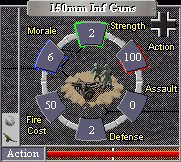
Game Statistics

|
| Victory Points |
Armour | Start | Start | End | End | ||
| Front | Side | Rear | Month | Year | Month | Year | |
| 5 | 0 | 0 | 0 | 9 | 39 | 5 | 45 |
| 150mm Infantry Gun | |||||||||||||||||||||||||||
| RANGE | 1 | 2 | 3 | 4 | 5 | 6 | 7 | 8 | 9 | 10 | 11 | 12 | 13 | 14 | 15 | 16 | 17 | 18 | 19 | 20 | 30 | 40 | 50 | 60 | 70 | 80 | |
| HARD | 10 | 8 | 5 | 2 | 2 | 2 | 2 | 2 | 2 | 2 | 2 | 2 | 2 | 2 | 2 | 2 | 2 | . | . | . | . | . | . | . | . | . | |
| SOFT | 24 | 23 | 22 | 21 | 19 | 18 | 17 | 16 | 15 | 14 | 14 | 13 | 13 | 12 | 12 | 11 | 11 | . | . | . | . | . | . | . | . | . | |
History
|
|
|
Specification |
|
Although the nomenclature is '33' this weapon was developed by Rheinmetall at the same time as the 75mm IG 18 and was first issued in 1927.The gun was conventional with a horizontal sliding-block breech mechanism and the carriage was a two wheel box-trail type with a hydropneumatic recoil system in a cradle below the barrel.The gun and cradle were trunnioned well to the rear to allow high elevation and two spring blancing-presses were fitted to the outside of the trail to counteract the muzzle weight.Pressed metal wheels with solid rubber tyres were fitted.While the s IG 33 was a reliable and robust weapon , it was somewhat on the heavy side for an infantry gun bearing in mind that it was the largest-calibre weapon ever classed by a nation as an infantry gun).In the late 1930s it was redesigned to incorporate light alloys wherever possible this effected a reduction in weight of about 150kg (331lb) but olny small numbers of this lightened model were built since it was introduced in 1939.The outbreak of war shortly afterwards revised priorities and gave the Luftwaffe first call on light alloys to facilitate aircraft production.Production of the s IG 33 thereupon reverted to the original pattern of carriage.The gun remained in service until 1945 and in postwar years many were kept in use by some of the smaller European nations. |